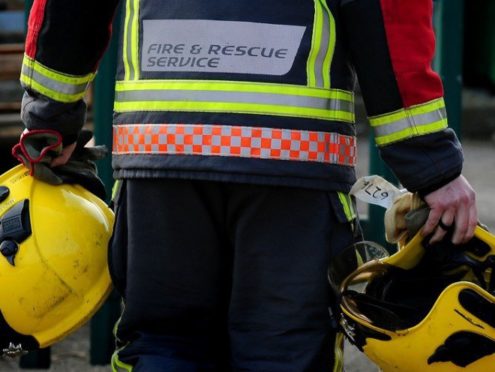False fire alarm calls at north hospitals is costing a staggering £1million a year, the Press and Journal can reveal.
Firefighters across the Highlands and Islands, Moray, Aberdeenshire and Aberdeen attended a staggering 2,693 unnecessary “blue-light” calls since 2013.
There were 991 false alarms in the Highlands and Islands – where Raigmore in Inverness is the largest hospital – and 1,383 in Aberdeen – where Foresterhill is the biggest.
Crews are legally required to attend all unwanted calls – described as a “drain on resources” – potentially taking them from a real emergency.
The cost of every incident – known by the service as unwanted fire alarm signals (UFAS) – is estimated at around £1,970, according to The Department for Communities and Local Government.

It means hospital false alarms has cost the fire and rescue service approximately £5.3million since 2013, which puts additional pressure on already-stretched budgets.
The shock figures were revealed following a Press and Journal under Freedom of Information request.
MSP John Finnie said: “The figures make worrying reading. I greatly appreciate the work of the Fire and Rescue Service does to both prevent and highlight the problems caused by false alarms.
“Automatic Fire Alarms are an important part of keeping people safe and that’s particularly the case with hospitals.
“However, firefighters attending those false alarms are not be available to deal with what might be a real emergency, with lives at stake.
“I hope the hospital authorities will redouble their efforts to ensure the best quality of alarms are fitted and the highest standard of maintenance is in place to eliminate false calls.”
Highland Council’s strategic lead for police and fire, Councillor Matthew Reiss, admitted the figure “sounds startling”, but as a fire service the crews have to respond to every call out.
He added: “The service is trying to reduce false calls to a minimum by working with repeat offenders, but fire safety is paramount and we have to accept that false alarms do happen.
“They are an inconvenience and it is worrying there are so many blue-light emergencies that are not necessary.
“But the fire service is in dialogue with fire alarm installation companies and hopefully new technology can help reduce numbers over the coming years.”
David Farries, the Scottish Fire and Rescue Service’s Deputy Assistant Chief Officer for the North of Scotland, said: “We have and will continue to work closely with all of our community partners across the North of Scotland to identify ways to reduce the number of unwanted fire alarm signals.
“This proactive approach has already seen a recent reduction in the number of call-outs in a number of areas, including Aberdeen City.”
He continued: “Unwanted fire alarm signals can divert SFRS resources away from genuine emergencies and result in unnecessary blue light journeys for our firefighters.
“It can also result in the danger of staff becoming complacent.
“We are committed to working with duty holders and our partners to, where appropriate, improve arrangements within premises to reduce the number of unwanted fire alarm signals.
“This assists duty holders to understand and manage their fire alarm systems to reduce disruption and the number of unnecessary blue light journeys.
“However, through robust and flexible strategic planning, our crews are always ready to respond to any incident to keep our communities safe.”
Reaction
An NHS Grampian spokeswoman said: “We recognise the challenges caused by unwanted fire alarm signals (UFAS). These challenges include the disruption to our day to day activity, the resource implications for the Scottish Fire & Rescue Service (SFRS) and the associated financial cost to the public purse.
“This has to be considered alongside the need to have an early detection of fire in our premises to safeguard our patients, staff and visitors.
“NHS Grampian are working in partnership with SFRS via a UFAS forum group to tackle this. The UFAS within NHS Grampian are primarily on the Foresterhill Health Campus and Royal Cornhill Hospital sites.
“Some of the actions we are taking are recording and investigation of all UFAS via the “Datix” reporting system, guidance and awareness campaigns and fitting of two stage covers to some break glass call points to reduce accidental activation.”
>> Keep up to date with the latest news with The P&J newsletter
An NHS Highland spokesman said: “The apparent appearance of consistent numbers of false alarm call outs to NHS Highland premises can be attributed to a number of reasonable factors.
“Owing to the large number of premises which NHS Highland occupy, and subsequently the consequent high numbers of smoke detectors employed within our premises, the numbers of false alarm activations are well within British Standard acceptable limits.
“However, that is not to say that we do not take false alarm activations seriously and work closely with SF&RS to further manage our premises as demonstrated by a recent communication from SF&RS, which outlined a downward trend in the number of false alarms as highlighted to NHS Highland in a recent audit report.”
Moray MSP Richard Lochhead said: “Our firefighters have no choice but to turn out in significant numbers to incidents at hospitals for obvious reasons and it is therefore vital that every effort is made by the NHS to ensure that alarm systems are working properly, to minimise the number of false alarms.
“Particularly in more rural areas, the fire service could quickly find itself overstretched if more than one emergency call occurs at the same time.
“This is of course an issue facing many organisations and not just hospitals and every authority has a role to play in reducing the number of false alarms.”
